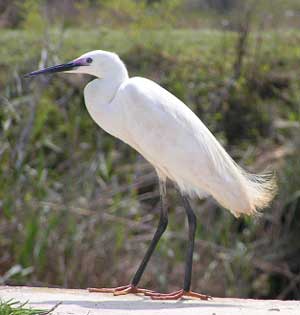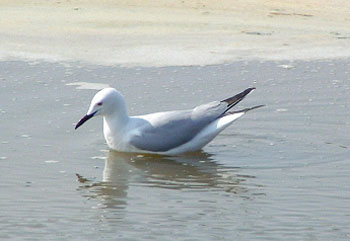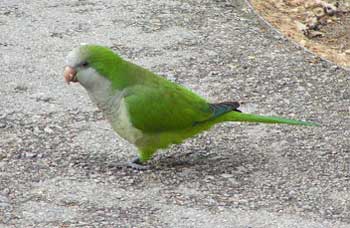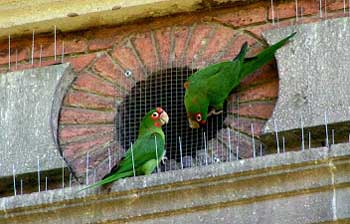INTRODUCTION.
During May we made a trip to France and northeast Spain, partly business, partly birding; there was no rigid birding itinerary. The Ebro Delta was the only site we had definitely planned to visit. In the event, we managed to squeeze in a fair amount of birding, including a few days at the Ile de Re, a large island in the Bay of Biscay. Although too late for mass migration, both sites were excellent for breeding birds, and the Spanish coast still held passage migrants. We returned to France via the Pyrenees, checking out likely looking areas en route. We managed some more birding in northern France, before taking the return ferry to Dover, four weeks after we set out, seeing a total of 198 species.
SITES VISITED.
La Brenne, central France, a brief visit on 4/5/04.
Ebro Delta, Catalunya, Spain, visits on most days 8-14/5/04, whilst staying on the coast at L'Ametlla de Mar.
Pyrenees, Rabassa Forest, Andorra, Estany de Sant Maurici [Espot], Spain, 15-17/5/04.
Ile de Re, France, plus brief visit to Yves Marshes, 23-25/5/04.
Northern France, Orne estuary, Caen; Marquenterre [Somme], 26-28/5/04.
ACCOMMODATION.
We took a tent and camping gear, camping in France when not staying with friends near Poitiers. In Spain we stayed in a log cabin at L'Ametlla de Mar. Exceptions to this were the Pyrenees and Marquenterre. In the Pyrenees we found that no campsites opened until 1st June, even those that were supposed to be open all year, according to the Alan Rogers guide. Here we used 2-star hotels. At Marquenterre we stayed at a 2-star hotel on our last night, mainly for that much needed soft mattress!
Accommodation at main birding sites;
Ebro Delta: Camping Caravaning L'Ametlla Village Platja, Paratge Santes Creus, 43860 L'Ametlla de Mar, Spain. Tel. 977 26 77 84
www.campingametlla.com email
info@campingametlla.com
An excellent base for birders, right on the coast and on its day a real migrant trap. Situated in a protected natural area, main interest lies in the terraced valley immediately adjacent to the camp on the north side, with two small lagoons, that opens out to the sea. Access is 100 metres from campsite entrance. Many birds were found inside the camp, particularly the north side overlooking the valley.
Facilities for tented camping, caravans and motor caravans. 80+ log cabins. 2 swimming pools, supermarket and restaurant. Food in the restaurant is superb and very good value. Cabins have hot water, showers, fridge and hotplate.
Total cost 179.31 Euros for 7 nights including tax [ £120 ]: not much more than a pitch as the camping is expensive.
The Ebro Delta starts about 15 kms south. There are plenty of camping sites on the delta, but most looked a bit dilapidated, and some weren't open.
Ile de Re: Le Cormoran camping, Route de Radia, 17590 Ars en Re, France. Tel. 05 46 29 46 04
www.comoran.com email
info@cormoran.com
Very nice campsite close to the main birding area of Lilleau des Niges.
Facilities for tented camping, caravans and motor caravans. Swimming pool and bar-restaurant. Large pitches and friendly staff.
Cost 15.50 Euros/night for pitch, car and two people [ £10.50 ]. There are many campsites on Ile de Re, all about the same price. Static on-site caravans are expensive, and only available for weekly rentals.
We used the Hotel Auberge de la Dune, 80550 Saint Firmin Les Crotoy, France, tel. 03 22 25 01 88; about 3km from the entrance to Marquenterre, between there and Le Crotoy. Quiet, comfortable with good food. Cost 50 Euros/room/night [ £34 ].
SITES.
[WWBNES = Where to watch birds in north and east Spain, WWBF = Where to watch birds in France, BGFSL = A birdwatching guide to France south of the Loire.]
Ebro Delta.
The site is covered by three very good websites, all in English, as well as WWBNES.
www.terra.es/personal/ecoima/spainbirding.htm
www.gencat.net/mediamb/pn/espais/delta-ang.htm
www.ramsar.org/lib_bio_6htm#cs3
On the practical side, it's well worth going straight to one of the two excellent info centres at Deltebre [north side] or Casa de Fusta [south side] to pick up a free copy of their coloured map/info sheet. Both centres are sign-posted, Casa de Fusta being on the north side of the huge l'Encanyissada wetlands.
 |
| Little Egret, Ebro Delta, showing the pink-red lores and feet of breeding plumage |
The Ebro has 50,000 inhabitants over 320 square kilometres, mostly involved in agriculture and the rice growing industry. That means a fair amount of traffic, particularly tractors. It's also a resort area, with dune-backed sandy beaches, fishing, cycling, etc. Some roads are narrow with rice paddies on either side. I would think it would be fairly chaotic trying to bird here during the summer holidays, Easter, or even most weekends in spring and summer at least. We managed to avoid weekend visits, and it was still quite busy. Beware the paddy field tractors with wide wheels - once they're on the road they don't like to stop!
The size of the delta is deceptive - in five days birding we still didn't see all the birding sites, missing out on Olles Lagoon, Fangar peninsula, Illa de Buda and Punta de la Banya. The Punta is reached by driving eight kms along the sandy isthmus. I attempted this once, but after a couple of kms hit deep, wet sand and basically bottled it! If I'd been in a hire car I may have chanced it. Huge lorries make it to and from the salt works on the Punta, but have equally huge ground clearance. The route may well be covered on a spring tide, as there are many wet bits. It's really up to the individual.
 |
| Adult Slender-billed Gull, La Tancada, Ebro Delta. |
With 300+ species recorded it's a superb area to explore, and an excellent place for a few species that can be difficult elsewhere;
Collared Pratincole, Gull-billed Tern and
Slender-billed Gull are easily seen in fair numbers for example, as well as having the world's largest breeding colony of
Audouin's Gulls. It would be a good place for digiscoping.
On a more worrying note, 90+ percent of the rice paddies were completely birdless.
Marsh Harriers were scarce and apparently no longer breed here; in fact it was very poor for raptors. Presumably heavy use of pesticides is the problem - see ramsar website. At least this does seem to concentrate the birds in certain areas.
Ile de Re, Poitou-Charentes, France:
Covered by one website mostly in French, also in WWBF and rather briefly in BGFSL.
www.lilleau.niges.reserves-naturelles.org
Lilleau des Niges is definitely the best area I could find at this time of year, covered by WWBF. The Maison du Fier is the reserve information centre, well signposted along the main road to les Portes en Re. From here there is a network of paths and cycle tracks skirting the lagoons and saltings. Good for breeding waders, terns and gulls, quite good for raptors [5 species/day], excellent for breeding Bluethroats, and would clearly be very good during migration. 304 species have been recorded on the island up until 1995.
Access to the island is by 3 kilometre toll bridge from La Rochelle, cost 9 Euros [£6] from 12/9 to 19/6/2004, and a steep 16.50 Euros [£11] 20/6 to 11/9/2004; both return ticket prices per car.
There are many good beaches, restaurants and interesting old towns here, although it is very much a holiday island. As with the Ebro Delta, the roads become very congested at times, and summer holidays would be extremely busy.
Yves Marshes, south of La Rochelle, is accessed directly from the N137 southbound and is signposted. The info centre at Marouille was closed and looked permanently closed. We parked here and walked as directed in WWBF along the dunes but views of the wetland area distant. Not the ideal place for a scope as it's a nudist beach! The reserve is completely fenced off and without entry, although there are two hides up the north end. Saw little, but had good raptor passage with
Montagu's Harrier, Honey Buzzard, 3
Hobbies and 3
White Storks all passing west, as well as
Black Kites, Marsh Harriers, Buzzards and
Kestrels over the marshes.
www.marais.yves.reserves-naturelles.org -partly in English.
Pyrenees:
(i) Rabassa Forest
Situated c15 kms east of Sant Julia de Loria, Andorra, we found this site whilst staying the night at the Hotel Coma-Bella
www.hotelcomabella.com, about 6 kms along this road and on the way to the ski station. At the top there are some marked trails. Very good for
Citril Finch and
Lammergeier, also
Crossbill, Crested Tit and other high altitude birds.
(ii) Estany de Sant Maurici/Espot.
Covered in WWBNES, which I'd left at home, I thought I'd discovered a real gem. Anyway, worth doing for possibly the finest mountain scenery I've seen in Europe. It is now not possible to drive from Espot to the lake [ref WWBNES]; one must park about 3 kms west of the village, where there is parking and a reserve ranger on hand. A well-marked trail from here to the lake takes about five hours return, birding along the way. Birds seen included
Citril Finch, Black Woodpecker, Lammergeier, Dipper, Rock Bunting, also Pine Martin, Roe Deer and Camberwell Beauty.
L'Orne Estuary and The Somme:
(i) The Baie de L'Orne
A promising area barely covered in WWBF just north of Caen. La Maison de la nature et de l'estuaire, Sallenelles, [tel. 02 31 78 71 06] is the info centre for the reserve, open 14:00 to 18:00, and is signposted along minor route 514 just west of Sallenelles village on the east bank of the estuary. Available here is an excellent map of all the paths, cycle tracks and roads relevant to birdwatching. In a short visit, the area was good for
warblers, gulls, terns, waders and
Spoonbills around La Maison area, with the jetty opposite Ouistreham looking good for seawatching in season. There are some hides overlooking 2 or 3 lagoons near La Maison. Nice to do on a visit to Caen.
(ii) Marquenterre.
www.marquenterre.fr/
www.baiedesomme.org/htm/fr/approche-carto/index-marquenterre.htm
Both sites in French - the second site very good for species list, etc.
Well known to British birders and reasonably well covered by WWBF, I totally agree with John Cantelo's view [see references] that it's a love/hate thing - I loved it. Once through the 'zoo' [two lagoons closest to the entrance], it's Minsmere, Dunge and Rye Harbour all in one. Volunteer birders/guides on hand for latest info.
Open all year except 1st Jan and 25th Dec.
Opening times:
02/1 to 30/1 and 12/11 to31/12: open 10 am to 5:30 pm, last entry 3 pm.
31/1 to 31/3 and 01/10 to 11/11: open 10 am to 5:30 pm, last entry 4 pm.
01/4 to 30/9: open 10 am to 7:30 pm, last entry 5 pm.
There is a restaurant, bar and shop.Entrance 9.60 Euros [£6.50].
REFERENCES.
Where to watch birds in North & East Spain, Michael Rebane, Helm. The standard reference and a superb one at that - pity I didn't take it [it was supposed to be a business trip].
Where to watch birds in France, LPO, Helm. 1992 translation of 1989 publication. Pretty awful, but the only one available to me on the trip. There is a 2004 edition but I understand it's a straight reprint. In France there's an updated version, obviously in French.
A birdwatching guide to France - South of the Loire including Corsica, Jacquie Crozier, Arlequin Press. I have to confess I overlooked this book as one of those small Arlequin guides; it's actually a full 288 pages. Having bought it since returning, it is excellent, a viable alternative to WWBF and actually much better, although coverage of Ile de Re is pretty scant. Has some great artwork by John Busby, adding charm to a very useful book. The companion book covering northern France looks very good as well, giving full coverage over two books and twice as many pages as WWBF.
Arnoud Van Den Berg's Where to watch birds in Holland, Belgium and Northern France, Hamlyn, must be good, but not sure of the range in France. Also I believe it's now out of print.
Spain and Portugal - Quality camping and caravanning sites 2004. Alan Rogers guide. Good, but not all sites mentioned as open all year are.
Michelin maps France, Regional, number 521 Poitou-Charentes. Ile de Re, etc.
Michelin maps Spain, Regional, number 574 Aragon, Catalunya. Ebro Delta, etc.
Other websites not already mentioned:
www.rarebirdspain.net Richard Gutierrez's superb site, with English version.
www.seo.org SEO website, Spanish only.
www.wild-spain.com Spanish wildlife issues. English version.
www.parc-naturel-brenne.fr La Brenne website, English version but not exactly bird-orientated.
Internet trip report: Cross Channel Birding by John Cantelo. Excellent reference for all sites easily reached via Calais/Boulogne ferry.
Bird List.
1. Black-necked Grebe - 2-3 La Brenne, 1 Marquenterre.
2. Little Grebe
3. Great Crested Grebe
4. Fulmar - Channel crossing [outward] and breeding Cap Blanc Nez.
5. Gannet - Channel crossing [outward].
6. Cormorant
7. Bittern - 1 Canal Vell, Ebro.
8. Little Bittern - 2 m. Canal Vell, 2 m. 1 f. L'Encanyissada, Ebro.
9. Night Heron - 1 m. Marquenterre, where apparently 1+ pairs breeding.
10. Cattle Egret - Very common Ebro, pair nesting Marquenterre.
11. Squacco Heron - Common Ebro.
12. Little Egret
[ Little Egret/Western Reef Heron - hybrid 1 La Tancada, Ebro, well documented by Spanish Rarities Committee.]
13. Great Egret - 2 breeding plumaged adults El Garxal, 2 non-breeding plumaged adults Canal Vell, Ebro.
14. Grey Heron
15. Purple Heron - 1 adult La Brenne, very common Ebro.
16. White Stork - 3 WSW over Yves Marshes, 2 pairs nesting Marquenterre with 3 and 1 young respectively, possibly re-introduced/feral.
17. Spoonbill - 12 Orne estuary, Caen, 25+ [10+ pairs nesting] Marquenterre.
18. Greater Flamingo - 300+ Ebro.
19. Mute Swan
20. Greylag Goose - Common feral breeders Marquenterre.
21. Canada Goose - As above.
22. Shelduck - Scarce Ebro, fairly common Ile de Re, Marquenterre.
23. Mandarin - 1 m. on river at Montmorillon, France.
24. Mallard - 3000+ Ebro.
25. Gadwall - Small nos. La Brenne, scarce Ebro, common Marquenterre.
26. Shoveler - 1 pair La Brenne, common Marqenterre.
27. Wigeon - 1 f. Marquenterre.
28. Teal - 1 m. La Brenne, 1 m. Marquenterre.
29. Garganey - 2 m. Marquenterre.
30. Pochard - Small nos. La Brenne, Marquenterre.
31. Red-crested Pochard - 2 m. 1f. La Brenne, 1000+ Ebro.
32. Tufted Duck - Small nos. La Brenne, Marquenterre.
NB Le Parc Ornithologique Du Marquenterre has two lagoons close to the entrance that hold a collection of wing-clipped wildfowl, also a rehabilitated Common Crane that can't fly, etc. Wildfowl include Ferruginous Duck, Scaup, R/C Pochard and Barnacle Goose.
33. Eider - 1 adult m. +1 adult f. +1 first-summer m. Orne estuary, Caen.
34. Common Scoter - Flock of 6 seen Channel crossing [ outward ].
35. Lammergeier - Singles usually seen all high altitude areas in the Pyrenees, including Andorra. 3 Espot, Spain.
36. Griffon Vulture - Flocks seen 'El Ports' near Tortosa and regularly in the Spanish Pyrenees.
37. Short-toed Eagle - 1 L'Ametlla campsite, 1 near Flix, 1 near Espot, Spain.
38. Red Kite - Mostly seen French Pyrenean foothills, but also 2 east of Sort, Spain.
39. Black Kite - Fairly common central France south to the Pyrenees. 20+ at refuse tip near Tortosa, Spain.
40. Marsh Harrier - 1 f. Channel crossing [outward], scarce Ebro [1-2 per day; apparently extinct as a breeding bird]; fairly common Ile de Re and Yves marshes, France.
41. Hen Harrier - Total 2 m. 1 f. central France.
42. Montagu's Harrier - 1-2 daily central France, 1 m. Spain.
43. Buzzard.
44. Honey Buzzard - 1 L'Ametlla campsite, 1 near Yves marshes, France.
45. Sparrowhawk - 1 Marquenterre.
46. Kestrel.
47. Hobby - Regularly seen in France, 1 L'Ametlla campsite.
48. Peregrine - 1 Aran Valley, Spanish Pyrenees.
49. Merlin - 1 prob. male briefly central France was a surprise.
50. Red-legged Partridge.
51. Quail - 4-5 heard Lleida steppes, Spain.
52. Pheasant - Isle de Re and northern France only.
53. Water Rail - 2-3 heard in Ebro reedbeds.
54. Moorhen.
55. Coot
56. Oystercatcher - 2 Ebro only.
57. Avocet - 50+ Ebro, 10+ Isle de Re, 20+ Marquenterre.
58. Black-winged Stilt - 2 La Brenne, 500+ Ebro, 20+ Ile de Re.
59. Collared Pratincole - 30+ Ebro.
60. Ringed Plover - 4 on paddy fields, Ebro.
61. Kentish Plover - 50+ Ebro.
62. Grey Plover - 11 Ebro, 2 Ile de Re.
63. Lapwing - France only.
64. Knot - 3 La Tancada, Ebro.
65. Sanderling - 6+ Ebro.
66. Turnstone - Small nos. Ile de Re.
67. Dunlin - c6 Isle de Re, 6+ near Caen.
68. Curlew Sandpiper - 5 La Tancada, Ebro.
69. Little Stint - 2 La Tancada, Ebro.
70. Common Sandpiper
71. Redshank
72. Greenshank - 2 La Brenne, few Ebro and Ile de Re.
73. Black-tailed Godwit - 1 paddy fields, 3 La Tancada, Ebro, 10+ Marquenterre.
74. Bar-tailed Godwit - 2 La Tancada, Ebro, 1 Marquenterre.
75. Curlew - 1 La Tancada, Ebro.
76. Whimbrel - 2 La Tancada, Ebro.
77. Ruff - 1 La Tancada, Ebro.
78. Black-headed Gull
79. Slender-billed Gull - 25+ Ebro.
80. Common Gull - 8+ Marquenterre.
81. Mediterranean Gull - 1 adult paddy fields Ebro, 100+ Marquenterre, 3+ Calais harbour.
82. Herring Gull [including yellow-legged].
83. Audouin's Gull - the common larus at the Ebro.
84. Lesser Black-backed Gull - 1 adult on paddy fields Ebro, several northern France.
85. Great Black-backed Gull - 1 adult Ile de Re, many near Caen, channel, etc.
86. Little Gull - 11 Marquenterre, all ages except juvenile.
87. Kittiwake - Both crossings, also breeding Cap Blanc Nez.
88. Little Tern - 20+ Ebro.
89. Sandwich Tern - Both crossings, 30+ Ebro.
90. Gull-billed Tern - Small flocks seen daily Ebro, usually over paddy fields.
91. Common Tern - 1 La Brenne, 30+ Ebro, 40+ Ile de Re, Channel crossing.
92. Caspian Tern - 3 sightings Ebro, Canal Vell,etc, all adults.
93. Black Tern - 2 La Brenne, 2 Ebro.
94. Whiskered Tern - 10+ La Brenne, 300+ Ebro.
95. Rock Dove/feral pigeon.
96. Wood Pigeon.
97. Collared Dove
98. Turtle Dove - 2 central France, 3 El Garxal, Ebro.
99. Cuckoo >1900 metres in Pyrenees.
100. Tawny Owl - 1 heard Montmorillon campsite, central France.
101. Long-eared Owl - 1 central France.
102. Barn Owl - 1 heard Montmorillion campsite, France.
103. Red-necked Nightjar - 2 L'Ametlla campsite most evenings.
104. Swift
105. Pallid Swift - 30+ L'Ametlla campsite.
106. Alpine Swift - Occasional sightings throughout in Spain, including Barcelona.
107. Hoopoe - 1-2 daily L'Ametlla campsite, 1 Ile de Re.
108. Bee-eater - Small flocks daily L'Ametlla.
109. Monk Parakeet - 30+ Parc de la Ciutadella, Barcelona; many carrying nest material. Cat 'C' [introduced with self-sustaining populations] on Spanish List, so technically speaking 'tickable'.

110. Mitred/White-eyed Parakeet - 8-10 Parc de la Cuitadella, Barcelona. All paired up and ready to go....4 pairs at least. Both species cat 'E' [introduced but not yet proven to have self-sustaining populations] on Spanish list. These were on the Catalyunian Parliament buildings! Both species cat 'E' but having not been to South America, I'm unsure which species this is.

111. Black Woodpecker - 1 f. Espot, Spain.
112. Green Woodpecker
113. Great Spotted Woodpecker - Various sightings including Andorra.
114. Skylark - 2+ northern France.
115. Crested Lark - Very common Ebro, etc.
116. Woodlark - 1 central France, 1 L'Ametlla campsite.
117. Short-toed Lark - 2 near LaTancada, Ebro.
118. Lesser Short-toed Lark - 2 El Garxal, 3 La Tancada, Ebro.
119. Sand Martin
120. Crag Martin - Small nos. throughout the Pyrenees.
121. Swallow - 1000's Ebro.
122. House Martin
123. Water Pipit - Common high altitude Pyrenees.
124. Meadow Pipit - 2 northern France.
125. Tree Pipit - c6 Cap Blanc Nez.
126. White Wagtail
127. Yellow Wagtail - 20+ Ebro; fairly scattered.
128. Grey Wagtail
129. Wren
130. Dipper - 1 Espot, Spain.
131. Dunnock >1900+ metres in Pyrenees.
132. Robin >1900 metres in Pyrenees.
133. Nightingale
134. Bluethroat - Many breeding pairs Ile de Re.
135. Redstart - 6+ L'Ametlla campsite, 1 f. Ebro.
136. Black Redstart >2000+ metres Pyrenees.
137. Wheatear - 2 m. 1 f. La Tancada, Ebro; common high Pyrenees to 2000+ metres.
138. Black-eared Wheatear - Fairly common high Pyrenees 2000+ metres.
139. Whinchat - 1 near La Tancada, Ebro.
140. Stonechat
141. Song Thrush - 1 Espot, Spain.
142. Mistle Thrush - 2+ Andorra, 3+ Espot, both at 1800 metres +.
143. Blackbird
144. Garden Warbler - 2 near La Tancada, 1 central France, 1 Marquenterre.
145. Blackcap
146. Lesser Whitethroat - 2+ Marquenterre.
147. Sardinian Warbler.
148. Whitethroat
149. Subalpine Warbler - 2 m. 1 f. near Sort, Spain.
150. Sedge Warbler - Common Marquenterre.
151. Zitting Cisticola - Common Ebro, Isle de Re.
152. Grasshopper Warbler - 1 reeling Maarquenterre.
153. Savi's Warbler - 1 L'Ametlla campsite on railway embankment, showing and reeling.
154. Cetti's Warbler
155. Reed Warbler
156. Great Reed Warbler - 1 L'Ametlla campsite, 3+ Ebro.
157. Melodious Warbler - Frequent sightings central and northern France; 3+ La Tancada, Ebro.
158. Willow Warbler - Scarce on passage; 1 L'Ametlla campsite, 2+ La Tancada ; common Marquenterre.
159. Wood Warbler - 1 briefly thro' L'Ametlla campsite.
160. Bonelli's Warbler - 1 near Cheveaux, central France.
161. Chiffchaff
162. Goldcrest - 4+ Espot, Spain.
163. Spotted Flycatcher
164. Pied Flycatcher - Good nos. of both flycatchers L'Ametlla campsite.
165. Great Tit
166. Coal Tit - Common Pyrenees throughout.
167. Blue Tit
168. Crested Tit - Common L'Ametlla campsite and the Pyrenees.
169. Long-tailed Tit - Only sightings 2 adults + 1 young Marquenterre.
170. Nuthatch - Several sightings Pyrenees.
171. Treecreeper - 1 Andorra at c1800 metres.
172. Red-backed Shrike - A pair on territory near Sort, Spain.
173. Woodchat Shrike - 1 m. 1 f. L'Ametlla campsite, 1 m. Tortosa, 2 Ebro.
174. Magpie
175. Jay
176. Jackdaw
177. Chough - 50+ 'El Ports' near Tortosa.
178. Alpine Chough - Fairly common Pyrenees.
179. Rook
180. Carrion Crow
181. Raven - 2+ refuse tip near Tortosa, fairly common Pyrenees.
182. Starling - France only.
183. Spotless Starling - Spain only.
184. Golden Oriole - Frequently heard in France.
185. House Sparrow
186. Tree Sparrow - 4 Canal Vell, Ebro; 2 Spanish Pyrenees.
187. Chaffinch
188. Linnet
189. Goldfinch
190. Greenfinch
191. Citril Finch - Common Andorra <1800 mteres, also Espot, Spain.
192. Serin
193. Crossbill - 1 m. 1 f. Andorra.
194. Reed Bunting - Fairly common Marquenterre.
195. Yellowhammer - Largest count 20+ flock at c1900 metres in Andorra.
196. Cirl Bunting
197. Corn Bunting - Scarce; few near Tortosa, Ebro, common Lleida steppes, Spain.
198. Rock Bunting - 1 pair near Sort, 2m. 1f. Espot, Spain.
Other fauna.
Red Squirrel - 2 Andorra, 1 central France.
Pine Martin - 1 near Estany de Sant Maurici, Espot, Spain. Excellent views of one of tese elusive creatures whilst we were picnicking on the forest trail from Espot to the Estany, lured by the prospect of an easy meal. Wary, but seen in the open twice.
Coypu - Several seen on small fishing lakes in central France.
Roe Deer - Several seen near Estany de Sant Maurici, Espot, Spain.
Chamois - Small herd seen near Espot, Spain.
Painted Lady, Swallowtail, Brimstone, amongst others; Camberwell Beauty 3+ Estany de Sant Maurici.




